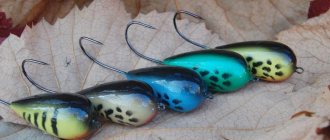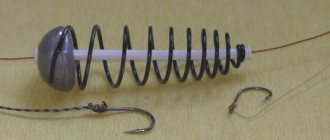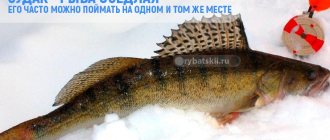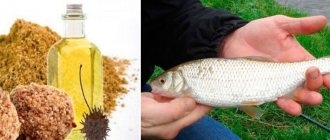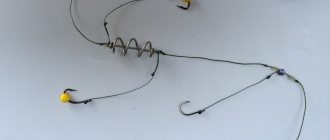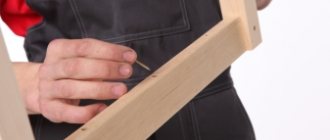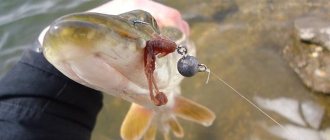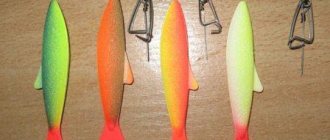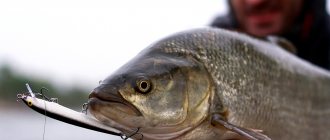Today, many older people remember the times of the Soviet Union with nostalgia. But you are unlikely to meet such people among experienced fishermen.
While behind the “Iron Curtain” fishermen were mastering new types of baits and fishing methods that regularly appeared, Soviet spinners were forced to fish with duralumin spinning rods and “Neva” reels, throwing spoons and spinners with disgusting quality hooks. Although, I must admit, among these baits there were some very worthy ones. And there were more fish then.
In the 70s of the last century, the first silicone baits appeared in the West and the “silicone boom” began. Our fishermen could receive only scanty information about such baits, and few were lucky enough to hold them in their hands. I urgently needed to come up with something of my own. And then the Moscow spinning fisherman Sergei Pavlov invented the foam fish .
Peculiarities
The main feature of foam fish is the material from which they are made, namely foam rubber . Foam rubber has a porous structure: when dry, the pores contain air, and water gradually penetrates into the pores if the foam rubber is immersed in it. Due to the fact that air remains in the water in the pores of the bait’s body, it occupies a vertical position at the bottom, which is a characteristic of a foam fish that distinguishes it from other baits.
It turned out that foam rubber lends itself well to processing : you can cut a fish of any desired shape from it. And finally, the most important thing. It turned out that foam fish are excellent baits for predators , primarily pike perch, but also pike, perch and other types of fish. True, at first it was not clear how to catch with new baits.
, the “Russian jig” or what we today call stepped wiring was invented . Like the bait itself, this can be considered a purely Russian invention, since the technique of fishing with jig baits in other countries is significantly different.
Expert opinion
Knipovich Nikolai Mikhailovich
Zoologist, hydrobiologist. I am interested in fishing at a professional level.
Interesting! After the appearance of silicone baits in our country, inquisitive fishermen conducted experiments to compare their catchability with the effectiveness of foam fish. In their experiments conducted in an aquarium with rotans, they more readily grabbed the “foam rubber” than silicone. And if the fish was moistened with fish blood, the rotan tried to literally swallow it.
Varieties of "foam rubber"
To successfully fish with foam rubber, you should choose one of the many options. Each of them can perform well in certain reservoir conditions.
- Some spinning anglers only use “foam rubber” that most closely resembles a live fish. They cut out the tail and fins, and paint the imitation to look like a roach or perch. And so that the bait moves in the water, it is made of two or three parts.
- Other anglers don't bother with the body shape, cutting out a bait resembling a carrot from foam rubber. Short models are equipped with a double bait, and long baits are made with a wire extension. In this case, the hook will be located closer to the tail and the effectiveness of bites will increase.
“Foam rubber” can vary significantly in size. This indicator must be selected for a specific predator.
- The smallest fish, 3-5 cm long, are suitable for catching perch. Accordingly, such miniature products require a small hook. It is placed in the tail section.
- To hunt pike perch with foam fish, it is better to choose models with a length of 6 cm or more. The twin must be placed in the head area of the soft bait.
- The toothy predator prefers large fish 6-12 cm long. The hook must be inserted into the middle part of the body of the foam rubber bait.
Application of attractants
The absorbent properties of foam rubber allow the successful use of various attractants. The simplest and, at the same time, effective is fish blood . The gills of the caught fish are cut and the bait is soaked in the blood that is released. But many fishermen are disgusted by this unaesthetic method. In this case, artificial attractants are used: anise, garlic, shrimp, etc.
Sometimes foam rubber is impregnated with fish oil . Some anglers are trying to make a long-lasting attractant . They mix fish blood with liquid silicone, add salt and glitter to make the bait more attractive. Fishing companies produce a lot of attractants designed for catching predatory fish. The pungent and unpleasant smell of some of them should not scare away the fisherman - it can be very attractive to fish.
Fishing technique
Paralons for fishing are used when fishing with jig-spinning . Their use with spaced equipment is impractical. Installation of the foam fish is extremely simple: it includes itself and an eared weight. If a non-separable “Cheburashka” is used, then you have to add one or two winding rings.
In most cases, a stepped jig . Russian fishermen are accustomed to making two or three turns with the reel handle, and then a pause, during which the bait freely falls to the bottom. Bites usually occur at this moment.
Some spinners use a method closer to American jig-spinning : they tear the bait off the bottom with a sharp movement with the tip of the rod, and then pick up the slack in the line with the handle of the reel. Using the installation features, you can use a foam fish to fish various hard-to-reach places.
Expert opinion
Knipovich Nikolai Mikhailovich
Zoologist, hydrobiologist. I am interested in fishing at a professional level.
Important! During the fishing process, the foam rubber is gradually saturated with water. Therefore, it should be squeezed out periodically to ensure the necessary buoyancy.
A foam fish does not have its own game ; all its movements are ensured by hinged mounting on a “eared” weight, i.e. during rewinding or pause, it wobbles to the sides relative to the load.
COLOR
Foam rubber models of a successful anatomical shape can be given the desired color, which, you see, is problematic to do with a dead fish.
Color and its capabilities have always been a mystery to me, but I have no doubt that in most cases it plays a decisive role. An endless number of examples can be cited in defense of color, but it has not yet been possible to find an explainable relationship. By answering some questions, you immediately receive new ones. A short example with a lot of “why?”
Enclosed reservoir, time - 11 am. The pike is quite active. The first bites occur on a black and white fish and on a tackle. A kilometer away, the fish begins to take brown and red foam fish, ignoring the tackle altogether. Why? The composition of the soil, bottom topography and lighting are, in our opinion, the same.
After half an hour in the second section, the bite occurs only on red fish; no one is interested in the tackle. Why?
After 3 hours, the fish come out again, but it reacts only to the red vibrotail, red twister and red foam fish, ignoring everything else. Why?
There are always a lot of such questions, but they all speak in defense of the version about the importance of color. Now spinning athletes are much more active in solving this issue; it was with their light hand that high-contrast baits were born, which, I must admit, do their job (photo 1).
1. Color options for high-contrast lures.
Once we were summing up the results of our fishing trip, and the phrase was said: “Today the fish is blind.” Maybe the “debriefing” would have ended there, but... I then thought: “Maybe she really is blind - to this or that color at different times of the day? Then this explains a lot in her behavior.”
The athletes puzzled me by asking me to make a “rainbow” bait (I didn’t come up with the name). What if illumination really affects the color spectrum visible to a predator? Then new opportunities open up.
Color is part of nature. You can ignore it - and then you can say that the fish don’t care. But I strongly doubt that in nature color is in vain. For me, the color world is better than black and white.
DIY making
Almost any angler can make a foam fish with his own hands. First of all, this requires material. They use foam rubber from dishwashing sponges, paint rollers and other household items. The foam should be dense. To make a fish, in addition to foam rubber, you will need: a sharp knife, scissors, a blade and glue (Moment glue or superglue).
Creating a blank
Usually, when making homemade baits at home, a rectangular block is cut out of a piece of foam rubber with a sharp knife, and then, using scissors, it is shaped into a fish . If you need to make a large number of baits, to speed up the process, use something like a pattern made from a sheet of metal or cardboard with a fish profile cut out in it.
Anglers cut out and then use two types of foam fish : with and without a tail. The former are often called “carrots” because of their similarity to this vegetable. It's easier to cut them out. To make fish, foam rubber of various colors is used: white, lilac, blue, green. White is needed if in the future the angler wants to color the fish. Other colors do not require additional coloring.
The shape of the fish does not depend on what kind of hook it will be equipped with; in any case, it is more or less elongated and is ultimately determined by the goals and objectives of the fisherman. The size of the fish depends on the size of the hook on which it will be mounted.
Hook mounting
Foam fish can be equipped with single, double and triple hooks.
- Regular single hook. A rig with an open hook point is used when fishing in places where there are no hooks. You can simply put the fish on the hook, as is done with silicone bait, or make a longitudinal cut on the back of the bait, insert the shank of the hook and seal the cut.
- Offset hook. The bait is put on the hook in the same way as a regular vibrotail, or a small incision is made from below at the head of the fish, the ledge of the hook is inserted there, sealed, and then the tip of the hook is inserted into the body of the fish so that it does not stick out.
- Double hook. To equip a fish with a double hook, make a cut from the head along the abdominal part of the bait and another cut perpendicular to it, insert a double and seal the cuts. You can use pliers to bend the forend, giving it a somewhat rounded shape. Then you won't have to make a perpendicular cut. This fish is used when fishing in places with a clean bottom.
Expert opinionKnipovich Nikolai Mikhailovich
Zoologist, hydrobiologist. I am interested in fishing at a professional level.
Healthy! In order not to break the hooks when bending them and in order not to spend a lot of effort on this, you should release the hooks on the flame of the lighter. This will only slightly reduce their strength.
Another option is a non-hooking fish. The whole process is repeated exactly the same, but the tips of the hooks should first be bent so that they are pressed against the body of the bait.
- Treble hook. Installation is carried out in the same way as when equipped with a double, but before inserting the tee, the back of the bait is pierced with the top hook.
Tips for rigging hooks
If the foam fish is of considerable length, you should use hooks with a long shank. Among single and double hooks, finding these is not a problem. The Japanese company Saiyko's assortment includes doubles with long and very long forends.
If there is a need to equip the bait with a treble hook, you will have to use two tees. They are inserted and glued into the body of the fish in exactly the same way, but the rear tee is attached to the front tee with a short piece of steel wire.
Painting
Many fishermen do not paint foam fish, considering it overkill. If you still want to give your bait a beautiful look, you can use permanent markers . Some people think that it is enough to paint the back of the fish black and the fins and tail red. Others give free rein to their imagination, making works of art out of lures.
Since foam fish appeared and began to be actively used when hunting predatory fish, debate has not subsided about how natural the bait should look. Those who believe that the color and coloring of the fish have no meaning, fish with rather crudely cut carrots. Their opponents, who hold the opposite point of view and stand on extreme positions, paint the fish in all the colors of the rainbow, insert bead eyes into them and make pectoral fins from lurex.
After much discussion, both sides reached some kind of consensus. It turned out that those spinning anglers who do not attach importance to the shape and color of the foam fish fish mainly in rivers . A predator living on a current constantly fights with it, and the hunt for prey is carried out according to the principle of “seen and grabbed.” Another thing is stagnant bodies of water . Here the predator has the opportunity to examine the bait, and coloring the foam fish may be justified.
Giving a fish a complete resemblance, for example, to a perch, is not a vital necessity , but if a fisherman is passionate about such applied art, then no one can forbid him from doing so.
Sinker
The weight for fishing with foam rubber fish is always a “Cheburashka” .
Collapsible weights, which appeared relatively recently, are very convenient if you need to quickly change the bait. The shape of the load may vary. As a rule, this is a ball, but when fishing in hard-to-reach places, it would be appropriate to use streamlined weights, for example, a “fish head”.
Top 5 foam lures
Fishing stores offer many products made from foam rubber. Some of them really attract a predator, while other models can be classified as soft toys. To prevent a novice spinning angler from throwing money away, it’s worth listening to the reviews of experienced fishermen. We offer you a rating of the best foam fish.
BNZ Sport
Many flattering reviews from both amateurs and athletes can be heard about the black foam rubber fish with a thin red tail. This is the BNZ Sport model, which is equipped with a double with stings pressed to the body. The length of the bait is 6 cm, which is most suitable for catching pike, pike perch and large perch. The manufacturer of Mamba (A. Kolomiets) took a creative approach to manufacturing, equipping the model with high-quality fittings. For some fishermen, the bait has been working properly for more than 5 years. Recommended for catching predators in snags and grass. The price of the product is 50-55 rubles.
OnlySpin bait 80
OnlySpin bait 80 foam products can compete with the most catchy silicone baits. All models are cut without heat treatment. Thanks to this technology, the softness and porosity of the foam rubber is preserved. In addition, baits are able to please their owners with their catchability for a long time. Each fish is equipped with a sharp Korean double, the stings of which are pressed tightly to the body. The length of the model is 8 cm, it is optimal for catching large pike and pike perch. The best reviews from anglers regarding blue and green products. You can buy an artificial fish for 140-160 rubles.
Photo 2. Foam rubber “OnlySpin bait 80”.
Classic Fish 10 CD
To produce fishing lures, the Lex Porolonium team uses only high-quality raw materials. It is characterized by density, rigidity, elasticity and porosity. "Foam rubber" Classic Fish 10 CD have an improved shape. Thanks to the flat back, more effective sweeps occur. The sharp points of the Saikyo hooks are hidden in the sloping gills, making the model “snag-free”. Since the bait is quite long, it is mainly large pike or trophy pike perch who bite on it. The cost of the model is 48 rubles.
Photo 3. Model “Classic Fish 10 CD”.
Levsha NN 3D Animator+ 90mm
Unusual-shaped soft baits are produced by the domestic manufacturer Levsha NN. The first thing that catches your eye is the large head of the fish. The long narrow body has a relief surface. Thanks to this shape, the artificial fish behaves more realistically when fishing. Brightly colored fins are attached to the head, behind which sharp hooks are hidden. With the 9 cm long model you can hunt both pike and zander. Lures with small weights work especially well. It is best to fish with this model in areas with standing water. The price of the product is 70-80 rubles.
Advantages and disadvantages
The advantages of foam fish are as follows:
- Easy to make bait. A foam sponge, a minimal set of tools and the fish is ready.
- Phenomenal catchability.
- Versatility. Using various methods of equipping the bait, you can catch it both on a clean bottom and in places with many hooks. Another advantage is the possibility of use at any depth, in currents and in standing reservoirs.
- Outstanding flight characteristics.
- Positive buoyancy. A bait standing vertically on the bottom attracts a predator much better than one lying passively on it.
- Indestructibility. Foam rubber, due to its dense structure, can withstand many times more bites than silicone baits.
- Possibility of using attractants.
- Cheap bait.
There are practically no disadvantages to foam fish. The lack of its own game can be considered a disadvantage , but this is due to the physical properties of foam rubber. As a result, foam fish are not used in spaced rigs. Some of the disadvantages of foam fish include its limited use when catching different types of predatory fish .
Still, the main trophy when fishing with foam fish is pike perch. Pike and perch are more favorable towards silicone baits.

